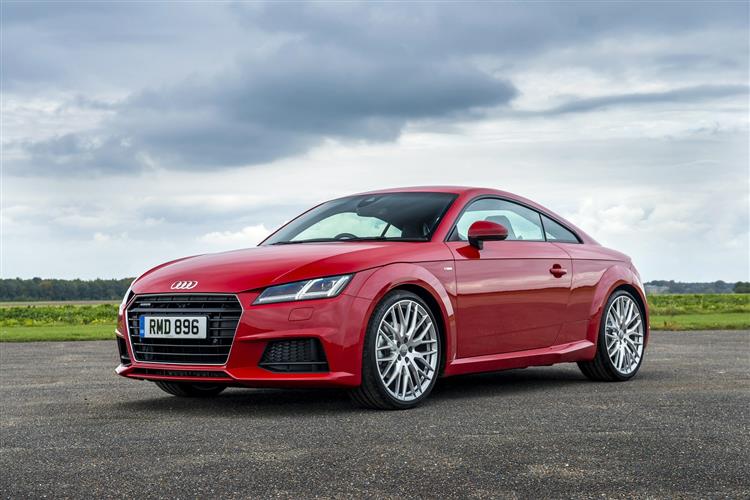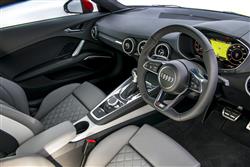YOUR CUP OF TT? (some text hidden) --NONE--
By Jonathan Crouch
Introductionword count: 70
The third generation Audi TT Coupe looks little changed from its predecessors. Don't be deceived. It's a very different thing to drive, to own and to live with. Which is important. The TT is fundamental to many people's perception of what this brand really stands for. It has to be right. It has to be vorsprung durch technic. But does it make sense as a used buy? Let's find out.
Modelsword count: 17
2dr Coupe (2.0 TDI / 2.0 TFSI petrol / 2.5 TFSI) [Sport, S line, TTS, TT RS])
Historyword count: 260
The original MK1 Audi TT was launched back in 1998 when it really was the thing to be seen in if you wanted a small, sporty coupe or roadster. Style personified, it broke the mould and defined its brand - a concept car you could actually buy. And from a conservative mainstream maker like Audi too! It was hard to believe. Only when you got behind the wheel of the thing did doubts begin to formulate, the drive on offer far less compelling than the pretty bodywork. A Golf GTI in drag? Some cynics thought so. Stung by their comments, Audi tried again in 2006 with a second generation model that was lighter and steered more sweetly. Still though, something was missing. It was sporting to be sure, but a 'sports car'? People like us still hesitated to call it that. In late 2014 though, Audi said we were to hesitate no longer, then bringing us this MK3 version, the car that perhaps the TT should always have been. More than merely a glorified design study: instead, a properly engineered driver's machine. With respectfully updated design and boundary-stretching technology, it referenced its predecessors but dispensed with their conservative approach to driving dynamics. It was lighter, leaner, faster and sharper through the bends, plus the brand offered even more responsive quattro technology. In short, we were promised a car in which, for once, the looks wouldn't lie. It sold until late 2018, when a facelift version was announced. Here, we're looking at pre-facelift 2014-2018 Coupe variants as a used car buy.
What You Getword count: 1089
Looks can lie. They did in the first generation version of this car, which promised excitement when on the driveway, but couldn't really deliver it on the road. With this MK3 version, there's again design mixed with deceit, whether you opt for your TT in Coupe or Roadster form. Both models do, after all, intentionally underplay the visual evolution that created this third generation design. Take the fixed-top Coupe model, which could, at first glance, easily be dismissed as nothing more than a gym-toned version of its rather ordinary MK2 predecessor. Many familiar TT styling cues are present and correct to play their part in this illusion: the rounded wheelarches, the curved windscreen pillars, the bold shoulder line and the sloping rear tailgate. As a result, you feel like you know this car before you even take a step towards it. Once you do though, you begin to appreciate quite different things about it. Like the fact that its shape references not only the past but also the present and the future. Take, for example, the detailing shared with Audi's R8 supercar, primarily the six-cornered singleframe front grille that forms the starting point for V-shaped contours that sweep back across the bonnet. By this point you'll be picking out many more timely touches. The razor-sharp headlights with their optional LED technology. The unique 'stirrup'-style door handles. The distinctive lower door sill contour - Audi calls it the 'dynamic line' - that forms a light-refracting edge and adds purpose to the car in profile. And maybe even the 'TT'-embossed fuel filler cap that opens with a light tap. Pull back the lid and there's no filler cap: instead the fuel nozzle is inserted directly into the tank neck - just like a race car. At the rear, the interplay between light and shadow intensifies around strong horizontal lines that define both boot lid and bumper. That boot lid incorporates a neat spoiler that automatically extends at 74mph and retracts again at 43mph. Further down sit two large, round chrome-tipped tailpipes. What's more important of course, is the stuff you can't see - a structure that was described by one writer as 'a steel cake with an aluminium frosting'. The allusion was to this car's so-called aluminium-hybrid construction that uses steel underpinnings (basically the smallest version of the Volkswagen's Group's latest MQB platform) allied to hi-tech aluminium body panels. It's a good compromise solution, saving weight (this model is around 50kgs lighter than its direct predecessor) without making this car impossibly expensive for the Hungarian factory to produce. That clever platform also enabled the design team to realise some of their apparently contradictory objectives for this MK3 TT model, namely to make it smaller, sportier and more 'chuckable'. Yet at the same time, also deliver a car that inside would be bigger and offer a larger boot. So it is that this third generation version is 21mm shorter than its predecessor yet, thanks to a wheelbase that's 37mm longer, offers more space within. Or a bit more anyway. Take the boot. Lift the tailgate and you'll find an unexpectedly large cargo area, something that's long been a selling point for TT owners. It's 305-litres in size with the rear seats up - 13-litres bigger than the MK2 model and certainly big enough for three or four large bags. The total cargo area on offer is within a whisker of what you could expect in a conventional compact sports coupe from this period like Volkswagen's Scirocco. And of course, it's miles more than you'd get in folding metal top roof rivals from this era like BMW's Z4 and the Mercedes SLK. If you need more room, then flattening the 50:50 split-folding rear backrest frees up a lot more of it - 712-litres to be exact. You might actually be folding the rear seats forward rather a lot because they remain as tiny as they've always been in a TT. As on previous TT models, they're almost unusable for adults and even children will probably grouse over long journeys. If taller folk do manage to cram themselves into the back, there's also the issue of their heads potentially being clonked by the closing tailgate. Having said all of that, we're pleased that Audi kept these chairs and didn't revert to the kind of two-seat-only design you'd get in a rival Mercedes SLK or BMW Z4 from this era. Many TT buyers do have families after all, running one of these as a second or third car. And in that situation, having back seats gives you options, even if only to run inebriated friends back from the pub. But we've saved the best bit until last. It's the up-front experience that'll really sell people this car, thanks to a clean-sheet design that really is different, classy and forward-thinking. How? Well once you're inside, look around you. What's missing? The wing-shaped dash is familiar enough, but in its centre, the usual infotainment system screen and ventilation control panel are both missing, allowing for a sleek minimalist design that really sets this cabin apart. Ventilation controls have been relocated to the jet turbine-style air vents and these can also house small digital displays which show the chosen setting. All the functions you'd normally find on a big tablet-style central display meanwhile, sit in what is possibly the most unique feature you'll find in this car: the 'Audi Virtual Cockpit'. This is a smartly presented 12.3-inch high resolution display that completely replaces the usual set of conventional dials and is viewed through the three aluminium-look-trimmed spokes of the redesigned flat-bottomed leather-stitched sports steering wheel. You'd think the digital screen would be somewhat over-burdened, having to take care of sat nav, audio and connectivity features as well as the usual driving dials. Not a bit of it. That's thanks to the pair of viewing options Audi offers here. First, there's what they call the 'Classic View' - which gives you a prominent speedo and rev counter. Alternatively, you can select the 'Infotainment View', which brings functions like this optional navigation map to the fore. In this setting, audio, telephone, media, trip and car settings can be dealt with by voice control, handled from steering wheel buttons or covered by fiddling with the touch-sensitive centre MMI controller below the gearstick. There's the option of tracing commands on the surface of a provided rotary dial with your fingertips - some compensation at least for front seat passengers who'll no longer have such control over what goes on in the cabin.
To see the full road test text contact us on 0330 0020 227
Pictures (high res disabled)

.jpg)
|
.jpg)
|
.jpg)
| |||
.jpg)
|
.jpg)
|
.jpg)
| |||
.jpg)
|

|
Scoring (subset of scores)
Category: Coupes
| Performance | |
| Handling | |
| Comfort | |
| Space | |
| Styling, Build, Value, Equipment, Depreciation, Handling, Insurance and Total scores are available with our full data feed. | |



